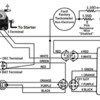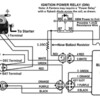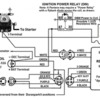Thanks to both of you, your help is appreciated.
Once I read Forest's comment about the pink wire being located between the ignition switch and the tach, the image of a picture from an old Chilton's book flashed in my mind. So I went to our storage unit this morning and grabbed the book, and inside was all my old notes from the early 1980s about Duraspark conversions. I forgot they were there. Talk about having your memory jogged!
With your help I was able to create a new schematic, and like everything else, here it is free for the benefit of anyone who needs it. The big difference between now and then …. back then we used wiring harnesses pulled from wrecking yard cars, today folks are using aftermarket wire harnesses such as the one available from Painless Wiring. The attached drawing is geared towards that situation.
Like Doug wrote, the pink wire is disabled, but it has to be replaced with a jumper and the new ballast resistance. Forest, I know substituting resistances will alter the tach readings (about 20%). My "argument" to owners has always been that the tach remains functional which is the owner's main corncern, and it is no less accurate than any of the other factory gages. In fact, I believe the new 1.10Ω ballast resistance is within the spec for the old ballast resistance (without looking it up I believe it was 0.7Ω to 1.7Ω). Substituting a coil could have just as much effect. The point being, the factory tach was not real accurate to begin with.
Besides, that's what they get when they take advice from the son of an Okie. Thanks again guys.
Pantera owners, this drawing isn't for you, it applies to Torinos, Montegos, Mustangs, Cougars, and Rancheros. Possibly Aussie Falcons and Fairlanes, I can't say for sure, I have no experience with the cars that stick to the road even though they are upside-down.
.




